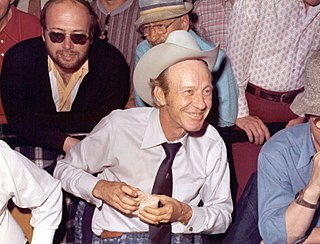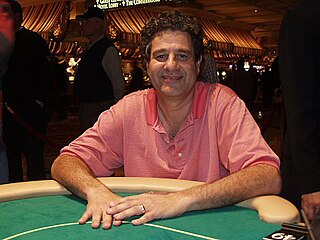Related Research Articles

John Anthony Cernuto also known as Miami, is an American professional poker player based in Las Vegas, Nevada, specialising in Omaha hi-lo events. Cernuto has won over $6,200,000 in live tournament winnings, his largest score was for $259,150 from his $2,000 No Limit Hold'em bracelet victory in the 1997 World Series of Poker.

The 1972 World Series of Poker (WSOP) was a series of poker tournaments held during early May 1972 at the Binion's Horseshoe in Las Vegas, Nevada. It was the 3rd annual installment of the World Series of Poker, and also the 2nd one to feature the freezeout structure. In comparison with the previous year's series, the number of events was cut back and the buy-ins were raised, resulting in 1 preliminary event and the Main Event both having the same buy-in of $10K. The preliminary event featured 5-card stud poker and was won by Bill Boyd, the same man who won the 1971 5-card stud preliminary event. The previous years' double champion Johnny Moss was defeated early in the main event and Thomas "Amarillo Slim" Preston went on to win the tournament after a series of deals.

The 2007 World Series of Poker was the 38th annual World Series of Poker (WSOP). Held in Las Vegas, Nevada at the Rio All Suite Hotel and Casino, the series featured 55 poker championships in several variants. As a WSOP custom since 1976, each of the event winners receive a championship bracelet in addition to that event's prize money. The series culminates with the $10,000 No-Limit hold'em "Main Event", which has attracted thousands of entrants since 2004. The winner of the WSOP Main Event, who wins a multimillion-dollar prize, is considered to be the World Champion of Poker.
David Baxter was an American poker player from Corpus Christi, Texas, who won two bracelets at the World Series of Poker.

Glenn Cozen is an American professional poker player from Pasadena, California, who is best known for his second-place finish in the $10,000 buy-in Main Event at the 1993 World Series of Poker.
The Super Bowl of Poker was the second most prestigious poker tournament in the world during the 1980s. While the World Series of Poker (WSOP) was already drawing larger crowds as many amateurs sought it out, the SBOP "was an affair limited almost exclusively to pros and hard-core amateurs."
The Super Bowl of Poker was the second most prestigious poker tournament in the world during the 1980s. While the World Series of Poker was already drawing larger crowds as more and more amateurs sought it out, the SBOP "was an affair limited almost exclusively to pros and hard-core amateurs."
The Super Bowl of Poker was the second most prestigious poker tournament in the world during the 1980s. While the World Series of Poker was already drawing larger crowds as more and more amateurs sought it out, the SBOP "was an affair limited almost exclusively to pros and hard-core amateurs."
The Super Bowl of Poker was the second most prestigious poker tournament in the world during the 1980s. While the World Series of Poker was already drawing larger crowds as more and more amateurs sought it out, the SBOP "was an affair limited almost exclusively to pros and hard-core amateurs."
The Super Bowl of Poker was the second most prestigious poker tournament in the world during the 1980s. While the World Series of Poker was already drawing larger crowds as more and more amateurs sought it out, the SBOP "was an affair limited almost exclusively to pros and hard-core amateurs."
The Super Bowl of Poker was the second most prestigious poker tournament in the world during the 1980s. While the World Series of Poker was already drawing larger crowds as more and more amateurs sought it out, the SBOP "was an affair limited almost exclusively to pros and hard-core amateurs."
The Super Bowl of Poker was the second most prestigious poker tournament in the world during the 1980s. While the World Series of Poker was already drawing larger crowds as more and more amateurs sought it out, the SBOP "was an affair limited almost exclusively to pros and hard-core amateurs."
The Super Bowl of Poker was the second most prestigious poker tournament in the world during the 1980s. While the World Series of Poker was already drawing larger crowds as more and more amateurs sought it out, the SBOP "was an affair limited almost exclusively to pros and hard-core amateurs."
The Super Bowl of Poker was the second most prestigious poker tournament in the world during the 1980s. While the World Series of Poker was already drawing larger crowds as more and more amateurs sought it out, the SBOP "was an affair limited almost exclusively to pros and hard-core amateurs."
The Super Bowl of Poker was the second most prestigious poker tournament in the world during the 1980s. While the World Series of Poker was already drawing larger crowds as more and more amateurs sought it out, the SBOP "was an affair limited almost exclusively to pros and hard-core amateurs."
The Super Bowl of Poker was the second most prestigious poker tournament in the world during the 1980s. While the World Series of Poker was already drawing larger crowds as more and more amateurs sought it out, the SBOP "was an affair limited almost exclusively to pros and hard-core amateurs."
The Super Bowl of Poker was the second most prestigious poker tournament in the world during the 1980s. While the World Series of Poker was already drawing larger crowds as more and more amateurs sought it out, the SBOP "was an affair limited almost exclusively to pros and hard-core amateurs."
The Super Bowl of Poker was the second most prestigious poker tournament in the world during the 1980s. While the World Series of Poker was already drawing larger crowds as more and more amateurs sought it out, the SBOP "was an affair limited almost exclusively to pros and hard-core amateurs."

Bryn Kenney is an American professional poker player from Long Beach, New York.
References
- ↑ "1981 SBOP: Doubling Up". Hand of the Day. Poker Listing. Archived from the original on June 28, 2009. Retrieved June 15, 2009.
- ↑ Reback, Storm (March 5, 2009). "From the Poker Vaults: Amarillo Slim's Super Bowl of Poker, Part I". PokerNews. Archived from the original on May 14, 2009. Retrieved June 15, 2009.
- 1 2 Wise, Gary. "1982 SBOP: A Win For the Longshot Doc". Poker Hand of the Day. Poker Listing. Retrieved June 19, 2009.
- 1 2 3 4 Reback, Storm (March 12, 2009). "From the Poker Vaults: Amarillo Slim's Super Bowl of Poker, Part II". PokerNews. Archived from the original on May 15, 2009. Retrieved June 15, 2009.
- ↑ "1984 Super Bowl of Poker $10,000 No Limit Hold'em". Tournament Results. The Hendon Mob. Retrieved June 16, 2009.
- ↑ "1984 Super Bowl of Poker Ace-to-Five Lowball". Tournament Results. The Hendon Mob. Retrieved June 16, 2009.
- ↑ "1984 Super Bowl of Poker $500 Ladies Limit Seven Card Stud". Tournament Results. The Hendon Mob. Retrieved June 16, 2009.
- ↑ "1984 Super Bowl of Poker $500 Pot Limit Omaha". Tournament Results. The Hendon Mob. Retrieved June 16, 2009.
- ↑ "1984 Super Bowl of Poker $500 Limit Hold'em". Tournament Results. The Hendon Mob. Retrieved June 16, 2009.
- ↑ "1984 Super Bowl of Poker $5,000 Seven Card Stud - Championship Event". Tournament Results. The Hendon Mob. Retrieved June 16, 2009.